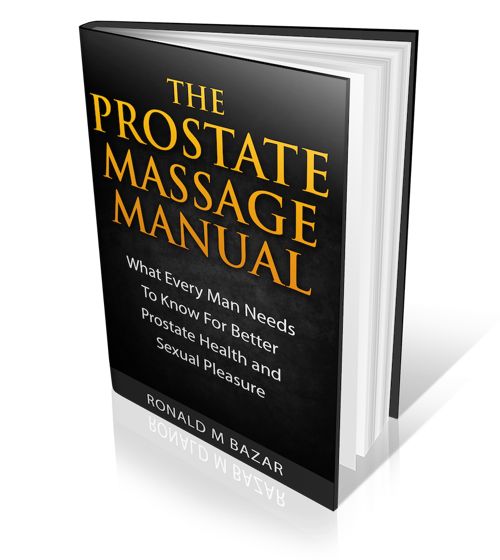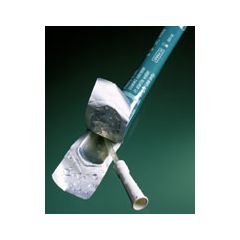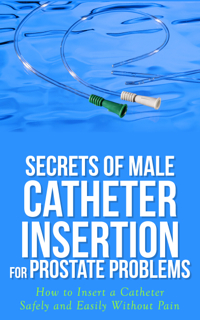
A Coude Catheter: Made for Easy Male Catheter Insertion and
Self Catheterization
A coude catheter is a special type of catheter for use by men especially if they have a prostate condition.
Coude is the name for the tip of the catheter. The tip is slightly bent or curved (about 1/8 of an inch) to help it get through the prostate more easily as it slides up your pee tube — your urethra.
It is ideal to use if you suffer from an enlarged prostate which makes catheter insertion more tricky because of the pressure on the pee tube — the urethra — caused by the enlarged size of the prostate.
Male Catheter Insertion
Self catheterization by men, the do-it-yourself male catheter insertion, is made so much easier with the help of the coude catheter. That little bend sure helps it get through the last bit.
A well-designed one will have a slight ridge on the opposite end of the catheter, the part you hold, so you can align it facing upwards so the tip is positioned correctly as it moves through your urethra to the prostate.
Sometimes they are called a coude tip catheter to explain its purpose. It's the same thing. If you have BPH, or enlarged prostate conditions, then this is the type of catheter to use. You can still get by with straight tipped ones but the help this ones gives is worthwhile to use if you have a choice.
Inserting a catheter is not hard to do and will not be painful, a bit uncomfortable but totally doable by you if you get a prostate attack and can't go!
My first choice is the SpeediCath Coudé Intermittent Catheters. That's it in the image above. They simply make catheter insertion as simple and pain free as possible.
It is more expensive than others (about $3 to $4—I paid $10 when I first found them!), but the ease of application in an emergency is well worth it. I have used $1 catheters, and they work but nowhere near as easily. Plus they are uncomfortable to use. Be extremely careful when buying catheters and ensure they are sterile; sterility has been built into the package design of these SpeediCath beauties.
You can order them by the box, or scroll down for the option of buying one at a time to try them out.
I will describe how to use the cheap ones on a different page (Male Catheter Insertion), but the SpeediCaths are more than well worth the extra price for the hopefully rare occasions that you will have to use them. They take the trauma and worry away, believe me, because I have had difficulties getting the cheap ones through the last inch or two on several occasions.
I once failed and had to call an ambulance. It took me 5 hours to get to the emergency room. Please don’t skimp here! I will share tips on the cheap ones in case that is all you have, but these SpeediCaths (either Coudé or straight) are the ones to buy. Period.
(Just enter the "SpeediCath Coudé Intermittent Catheters" in Search. You can then choose 12 FR, 14" Length (that means 12 gauge size). You can buy one at a time or a box for the best deal.)
Step-by-step instructions
Inserting a SpeediCath at Home:
- Gather all the above items, which you should have ready in a kit in a ziplock bag plus the towels and a plastic collection bottle for the urine. A liter or quart size is adequate.
- Wash your hands, including your thumbs, really well then wash your penis with the glans pulled back.
- Decide where to do the job. I really prefer lying down leaning up, which is different from the video. Why? Because unlike regular users who use catheters every day (perhaps because of a spinal cord injury), you are in trauma by now, having tried everything, and still you can’t release. You have an enlarged prostate problem. Lying down helps you relax and is less stressful than standing or even sitting (which is a good second choice). You do not have to be in the bathroom for this.
- Lay a protective towel under you and another to the side where your bottle will be to place the external end of the coude catheter tube to collect the urine.
- Place the items from the kit on the side towel.
- Pull back the tab on the back of the catheter package to expose the sticky part. Attach the sticky part to the bedframe or side table within easy reach and pull down on the pull-tab enough to expose the catheter top without touching anything inside.
- Take the bottle of alcohol, remove the cap and pour some onto the Kleenex or open the swipe pads. You can also use iodine wipes if you prefer. The goal now is to sterilize everything. Always remember that what you touch from now on must be wiped clean before using. And you must re-wipe your fingers if you touch something not yet sterile! Be very careful so as to avoid the risk of possible infection through careless use.
- Sterilize your hands and then the top of your penis with the glans pulled down. Using the alcohol, wipe your hands again.
- One hand (your dominant one) now takes the coude catheter out of the package by gently taking the top of the exposed catheter, pulling it out of the package and without touching the lower part guides the catheter tip into the opening at the tip of the penis while the other hand holds the glans down, tip opened and the penis vertical up from the body. It won’t be an erection at this point
- If the catheter by accident touches anything, then wipe the spot with a clean Kleenex with alcohol on it or a pad. Then reinsert. Be hyper-careful at all times that what goes into the penis is sterile.
- The coude catheter is stiff enough to hold its length as you insert it. Notice that on the external tip there is a line on the edge to show you which way the coude tip is bent. Have that mark facing you upwards... that is the correct angle for it to help pass through the prostate.
- Once in at the top, steadily push it and it will glide its way
through quite easily and with only minor discomfort.
- Once inside, you start to push at a steady slow pace. PULL YOUR PENIS UP STRONGLY SO IT IS STICKING STRAIGHT UP at a right angle to your body. STRETCHING IT WILL MAKE IT EASIER TO FIND ITS WAY THROUGH AS IT GOES DEEPER! THIS IS AN IMPORTANT TECHNIQUE!
- Remember to breathe deeply and relax! You are almost done! Continue to push it through.
- After 8-10 inches you will be coming through the prostate to the
entrance to the bladder, or may be at the entrance to the prostate.
- The sphincter muscle now has to relax enough to let the catheter through. So if you feel any resistance, STOP pushing. Finesse is the key to success now and the smooth tip will be helping you out.
- You basically want to knock on the door and give a bit of time for the sphincter to relax and open. Wait a good few seconds.
- Push gently. Never force. If it seems blocked and won't pass through, here is the trick to that...
Pull back and out a little bit (an inch or 2 cm) and then start forward in again.
Ensure that the line is up as we mentioned above.
Twist the coude catheter with your fingers maybe a quarter of a
turn or more and that will help find a way through. Keep twisting back and forth and
very gently pushing until it slips through the last little bit. Most
of the time it will go through without any problem.
But you now know
what to do just in case. I was taught this technique by a great
emergency room nurse who explained that “finesse is the trick.”
Oh had I known that! I had been forcing it, and it didn’t work
(causing blood to come out) and that was why I was there in the
emergency room. Never force it! (By the way I was not using a touchless catheter like the SpeediCath then.)
FINESSE - GENTLE - TWIST. You will succeed easily with this trick (if you should need it). I didn’t need it after I discovered the SpeediCath coude catheter. They are just so good! If at any time even before this last bit you encounter resistance then pull back a bit and use the finesse turning trick to help the catheter through.
Here's what happens next:
- Once you pop through into the bladder (and it will seem like a
lot of the catheter has disappeared inside—leaving 3-6 inches
outside), suddenly urine will squirt free from the external end. Just
put your thumb against the end and place it in the bottle. Then push
the coude catheter a little further so that it is well inside the bladder. (If you want, you can put your finger on the external tip before it enters the bladder, so as not to have the urine release into the air. Just place it in the bottle as you move it through the last bit.)
- Keep the bottle as low as you can beside you so gravity works to void the bladder.
- You should now be emptying and feeling such a wonderful sense of relief. Aaaah! Oh so good! At last relief!
- Job well done! Keep holding the coude catheter in place so that it doesn’t slip out a bit.
- Just lie there and feel the blessings of this little device that just saved your life!
- The bottle will be receiving more and more of the urine, slowing down eventually to a trickle.
- Relax and empty. Oh feels so good now!
- After a few minutes or so—there is no rush—and no more urine flows, then slowly remove a bit of the catheter towards the neck of the bladder. That may release the last bit of urine near the neck of the bladder.
- When done pull the catheter all the way out and discard beside you.
- Rest a bit before clean up.
- Sleep if you can.
- There is no need to worry now, because the act of putting the coude catheter through seems to open the channel and keeps it open after it is out. Soon, you will have your first pee. It may burn a bit as the ammonia in the urine touches any part that may have been irritated by the catheter but this should be very minor as these are such good catheters. Any discomfort will soon pass as the day progresses.
- If you do not know the cause, do your detective work and figure out what caused the prostate attack. Now is the time to personally test all that you recently ate.
It is really quite easy to use a coude catheter, even though I have gone into great length to describe what to do. You can use them anywhere you have to. I always travel with one or two and some alcohol wipes, especialy if you travel by air.
Catheter Prostate Kit
Here is a list of items to create the minimal Prostate Kit. You really won’t need the optional items, but I list them in case you can’t find the coude catheter: SpeediCaths. If you want other less expensive catheters, go here: Other Catheters
Minimum Prostate Kit:
- 1 SpeediCath catheter lubricated: SpeediCath Coudé Intermittent Catheters or Straight-Tip SpeediCath. Choose 12 gauge 14” (#28492 - 12 FR, 14" Length) catheter for men. Buy several so that you have back-ups for the car, home, work, travel bag, etc. 12 gauge is the thickness of the tube. If you can't get 12s then 14s are ok as well but not quite as thin. 10s are too thin.
- 6– 10 Alcohol Prep Pads. You can get 200 for a few bucks.
- Xylocaine (very optional): Xylocaine Ointment Tube or Lidocaine With SpeediCath, you really do not need these, but if you are worried, then get some.
- KY jelly (also very optional)
- A plastic ziplock bag to hold all the items together as your emergency prostate kit.
For home use:
- The same kit as described above, but you can substitute a bottle of alcohol with Kleenex tissues that you wet for sterilizing in place of the Alcohol Prep Pads.
- Include 2 towels.
Tip: Add a SpeediCath Coudé Intermittent Touchless Catheter to your first aid kit.
IMPORTANT
If you are having troubles inserting then it may be best to go to your emergency at your hospital!
In case you can't here is what to try.
In the very rare case that a lubricated catheter is unable to pass through the prostate using all the above techniques, Use a higher gauge one: if a 12 did not work, then use a 14. If 14 did not work, use a 16.
This is contrary to what you think that a thinner one would be easier to succeed. The problem is that it is not strong enough to push through your enlarged prostate. A wider one will do the trick!
Or if you have tried a 14 or 16 gauge and they haven't worked then dropping down to a 12 or 10 may be successful.
Make sure the blue line is pointing upwards so the coude tip is up and you will be able to push a little firmer. Use some Xylocaine before inserting as described earlier.
First Choice:
SpeediCath Coudé Intermittent Touchless CatheterSpeediCath Coudé Intermittent Touchless Catheter
---------------------
Others:
That's still a soft catheter.
Another option is a stiffer one:
But the size is the key when you have problems getting through. That is why it is wise to have a bigger size as a Plan B just in case.
Go from Coude Catheter to Catheter Insertion
Got a Question or Comment about your Prostate Health?
This is the place to post them because I get them immediately.
I like to share them and the answers I provide so others can benefit too.
Your email is kept completely confidential. If you want to be notified when the question is answered, please make sure to add your email address. I don't collect or store these emails after they are used to send you your answer, and they are not posted with your question.
What Other Visitors Have Asked or Said
Click below to see contributions from other visitors to this page...
Lidocaine
You mention Lidocaine to be included in your kit, but I am not sure where or what brand to purchase. I know it has to be water soluble but when I click …
WhatY ou Eat Can Affect Your Prostate Gland
In #13 above you said "Now is the time to personally test all that you recently ate." This was in regard to determining the cause of a prostate "attack". …
Not sure it worked
I self cathed myself for the first time after my TURP. Used the speed Cath and it went in fine, marginal pain but manageable. I got 6 oz at most and it …
Alcohol prep pads ?
I read the items in "The minimum prostate kit". I see you said you use alcohol prep pads. Are alcohol pad wipes ok for long term use?
They sure would …
Finding the cause of the prostate attack
Hi Ron, I recently discovered what causes my prostate to shut off the flow of urine, forcing me to save a trip to the emergency room by self cathing with …
HOW can I order?!
Where is your order form or phone # so I can order?
-------------
Click on the links!
traveling with the speedicath
I bought a half dozen coude tip speedicaths. I tried one out just to be sure I could do it and to experience cathing myself. Everything went very well, …
Thank you very much.
I ordered some speedicaths for emergency use. I recently suffered my first total blockage and had to make a painful 40 minute trip to the ER. My fault …
Catheter sticks sometimes
I self cath a few times a day using The "gentle cath" catheters. I have noticed once in a while after insertion, the urine is flowing and as I get empty, …
Using a coude catheter on the airplane
Hi, all this sounds good. I have an enlarged prostate. Most of the time I pee okay. Will be taking a long 6 hr flight. I seem to have trouble peeing on …
Sleep Secrets by the author of this website.

Healthy Prostate:
The Extensive Guide To Prevent and Heal Prostate Problems Including Prostate Cancer, BPH Enlarged Prostate and Prostatitis
Get all the info on this site plus much much more:
• extensive guide
• searchable content
• live clickable links
• organized flow of content
• product suggestions and how to lists
• reference links
• AND GET VERY IMPORTANT INFO NOT ON THIS SITE...








